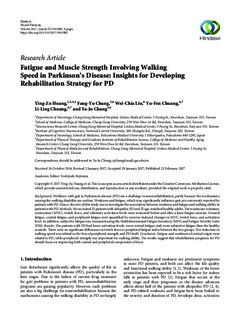| dc.contributor.author | Huang, Ying-Zu | |
| dc.contributor.author | Chang, Fang-Yu | |
| dc.contributor.author | Liu, Wei-Chia | |
| dc.contributor.author | Chuang, Yu-Fen | |
| dc.contributor.author | Chuang, Li-Ling | |
| dc.contributor.author | Chang, Ya-Ju | |
| dc.date.accessioned | 2019-03-05T13:37:14Z | |
| dc.date.available | 2019-03-05T13:37:14Z | |
| dc.date.issued | 2017 | |
| dc.identifier.citation | Ying-Zu Huang, Fang-Yu Chang, Wei-Chia Liu, Yu-Fen Chuang, Li-Ling Chuang, and Ya-Ju Chang, “Fatigue and Muscle Strength Involving Walking Speed in Parkinson’s Disease: Insights for Developing Rehabilitation Strategy for PD,” Neural Plasticity, vol. 2017, Article ID 1941980, 9 pages, 2017. | nb_NO |
| dc.identifier.uri | http://hdl.handle.net/11250/2588809 | |
| dc.description.abstract | Background. Problems with gait in Parkinson’s disease (PD) are a challenge in neurorehabilitation, partly because the mechanisms causing the walking disability are unclear. Weakness and fatigue, which may significantly influence gait, are commonly reported by patients with PD. Hence, the aim of this study was to investigate the association between weakness and fatigue and walking ability in patients with PD. Methods. We recruited 25 patients with idiopathic PD and 25 age-matched healthy adults. The maximum voluntary contraction (MVC), twitch force, and voluntary activation levels were measured before and after a knee fatigue exercise. General fatigue, central fatigue, and peripheral fatigue were quantified by exercise-induced changes in MVC, twitch force, and activation level. In addition, subjective fatigue was measured using the Multidimensional Fatigue Inventory (MFI) and Fatigue Severity Scale (FSS). Results. The patients with PD had lower activation levels, more central fatigue, and more subjective fatigue than the healthy controls. There were no significant differences in twitch force or peripheral fatigue index between the two groups. The reduction in walking speed was related to the loss of peripheral strength and PD itself. Conclusion. Fatigue and weakness of central origin were related to PD, while peripheral strength was important for walking ability. The results suggest that rehabilitation programs for PD should focus on improving both central and peripheral components of force. | nb_NO |
| dc.publisher | Neural Plasticity | nb_NO |
| dc.rights | Navngivelse 4.0 Internasjonal | * |
| dc.rights.uri | http://creativecommons.org/licenses/by/4.0/deed.no | * |
| dc.subject | fatigue | nb_NO |
| dc.subject | muscle strength | nb_NO |
| dc.subject | walking speed | nb_NO |
| dc.subject | Parkinson’s disease | nb_NO |
| dc.subject | rehabilitation | nb_NO |
| dc.subject | rehabilitation strategy | nb_NO |
| dc.subject | nevrologiske lidelser | nb_NO |
| dc.title | Fatigue and Muscle Strength Involving Walking Speed in Parkinson’s Disease: Insights for Developing Rehabilitation Strategy for PD | nb_NO |
| dc.type | Journal article | nb_NO |
| dc.source.volume | 2017 | nb_NO |
| dc.source.journal | Neural Plasticity | nb_NO |
| dc.identifier.doi | https://doi.org/10.1155/2017/1941980 | |

